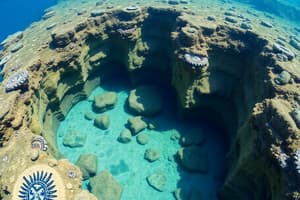Podcast
Questions and Answers
What is an anticline?
What is an anticline?
- A fold that arches upward (correct)
- A fold that arches downward
- A rock that fractures
- A type of fault
What is a basin?
What is a basin?
- An upward fold
- A type of fault
- A downward bend in circular structure (correct)
- A type of plate boundary
What is compression?
What is compression?
It squeezes rocks together, causing them to fold or fracture.
What is confining stress?
What is confining stress?
What is deformation?
What is deformation?
What is a dip?
What is a dip?
What characterizes a dip-slip fault?
What characterizes a dip-slip fault?
What is a dome?
What is a dome?
What is elastic deformation?
What is elastic deformation?
What defines a fault?
What defines a fault?
What is a fold?
What is a fold?
What happens in a fracture?
What happens in a fracture?
What is a joint?
What is a joint?
What is a monocline?
What is a monocline?
What characterizes a normal fault?
What characterizes a normal fault?
What is plastic deformation?
What is plastic deformation?
What is a reverse fault?
What is a reverse fault?
What is shear stress?
What is shear stress?
What is slip in terms of faulting?
What is slip in terms of faulting?
What is strain?
What is strain?
What is stress in geology?
What is stress in geology?
What characterizes a strike-slip fault?
What characterizes a strike-slip fault?
What is a syncline?
What is a syncline?
What happens to rocks under tension?
What happens to rocks under tension?
What is a thrust fault?
What is a thrust fault?
What causes uplift?
What causes uplift?
What is amplitude in relation to waves?
What is amplitude in relation to waves?
Flashcards are hidden until you start studying
Study Notes
Geological Structures and Deformation
- Anticline: An upward arching fold where the oldest rocks are at the center, with younger rocks draped over them.
- Basin: A downward bending circular structure; the oldest rocks are located at the center when exposed on the surface.
- Dome: An upward arching circular structure; cutting off the top reveals the oldest rocks at the core.
- Monocline: A simple bend in rock layers, altering their horizontal orientation.
Types of Faults
- Fault: A fracture where blocks of rock move; sudden movements lead to earthquakes.
- Dip-slip Fault: Characterized by a fault plane inclined relative to the horizontal, with two subtypes: normal and reverse faults.
- Normal Fault: The hanging wall drops relative to the footwall, typical of divergent boundaries.
- Reverse Fault: The footwall drops relative to the hanging wall, indicative of compressive stresses.
- Thrust Fault: A reverse fault with a nearly horizontal fault plane; can cause significant displacement.
- Strike-slip Fault: A vertical fault where movement is primarily horizontal, resulting from shear stress.
Stress and Deformation
- Compression: Squeezes rocks together, typically occurring at convergent boundaries, causing folding or fracturing.
- Tension: Rocks are pulled apart, leading to lengthening or fracturing, predominant at divergent boundaries.
- Shear: Occurs when forces move in opposite parallel directions, most common at transform boundaries.
- Confining Stress: The pressure exerted on deeply buried rocks by the weight of overlying materials, preventing deformation.
Rock Behavior Under Stress
- Elastic Deformation: Rock returns to original shape upon removal of stress.
- Plastic Deformation: Permanent change in rock shape without returning to the original form.
- Strain: The change in shape caused by applied stress.
Other Geological Concepts
- Fracture: The breaking of rock material; if no movement occurs along the fracture, it's classified as a joint.
- Dip: The angle of a fault relative to the horizontal surface, which helps classify fault types.
- Slip: The distance rocks move along a fault, which can vary and is defined relative to each fault plane.
- Uplift: The process where converging continental plates create mountains, causing folds and faults in the crust.
- Amplitude: Refers to the height of a wave from its center; relevant in the context of seismic activity.
Studying That Suits You
Use AI to generate personalized quizzes and flashcards to suit your learning preferences.




